Brand Storytelling: Definition, Examples & How To Do It Right
If you have an amazing product that is currently out of sight, we’ve just the thing for you – brand storytelling.
Picture this: you’re at a party, and someone tells a captivating story. Everyone hangs on every word, right? That’s the power of storytelling, and it works wonders for brands. When you share your brand’s story, you create an opportunity for customers to become part of your world, offering more than just a product.
Ready to craft a story that’ll hook new customers in, establish strong business credibility, and make your product shine? Let’s dive in.
What Is Brand Storytelling?
Brand storytelling is the process of developing and using a narrative about your brand that creates an emotional connection with the customers. Besides discussing your products and services, you explain why your brand exists and what it represents.
Unlike traditional advertising, which focuses solely on the product or service, brand storytelling centers around the experiences, emotions, and values that the brand embodies. These stories make your brand relevant and lasting. After all, stories are 22 times more memorable than just facts.
When planning your storytelling strategy, you should identify and add key elements to create an impactful brand story.
- Set the main character
- Specify conflicts or challenges
- Provide practical and effective solution
One company that really brings these 3 elements to life is Vitamart, an online health supplements store. This approach works across different industries but it’s especially important in health and wellness. People want to feel that a brand truly cares about their well-being because, after all, it’s their health on the line.
In niches where products or services aren’t as closely tied to personal well-being or trust, like some tech or office supply sectors, the emotional connection and personal story might not hit as hard.
So how did they do it?
Mark Holowaychuk, the founder, is the main character in Vitamart’s story. His journey from selling hockey cards and candy as a kid to becoming a passionate health entrepreneur is central to the brand’s narrative. This personal touch makes the story relatable and authentic.
Mark faced several challenges along the way. Initially, he was disappointed with the online health stores he encountered – slow shipping, lackluster customer service, and poorly designed websites. This dissatisfaction drove him to create something better, showing the genuine struggle and motivation behind Vitamart’s creation.
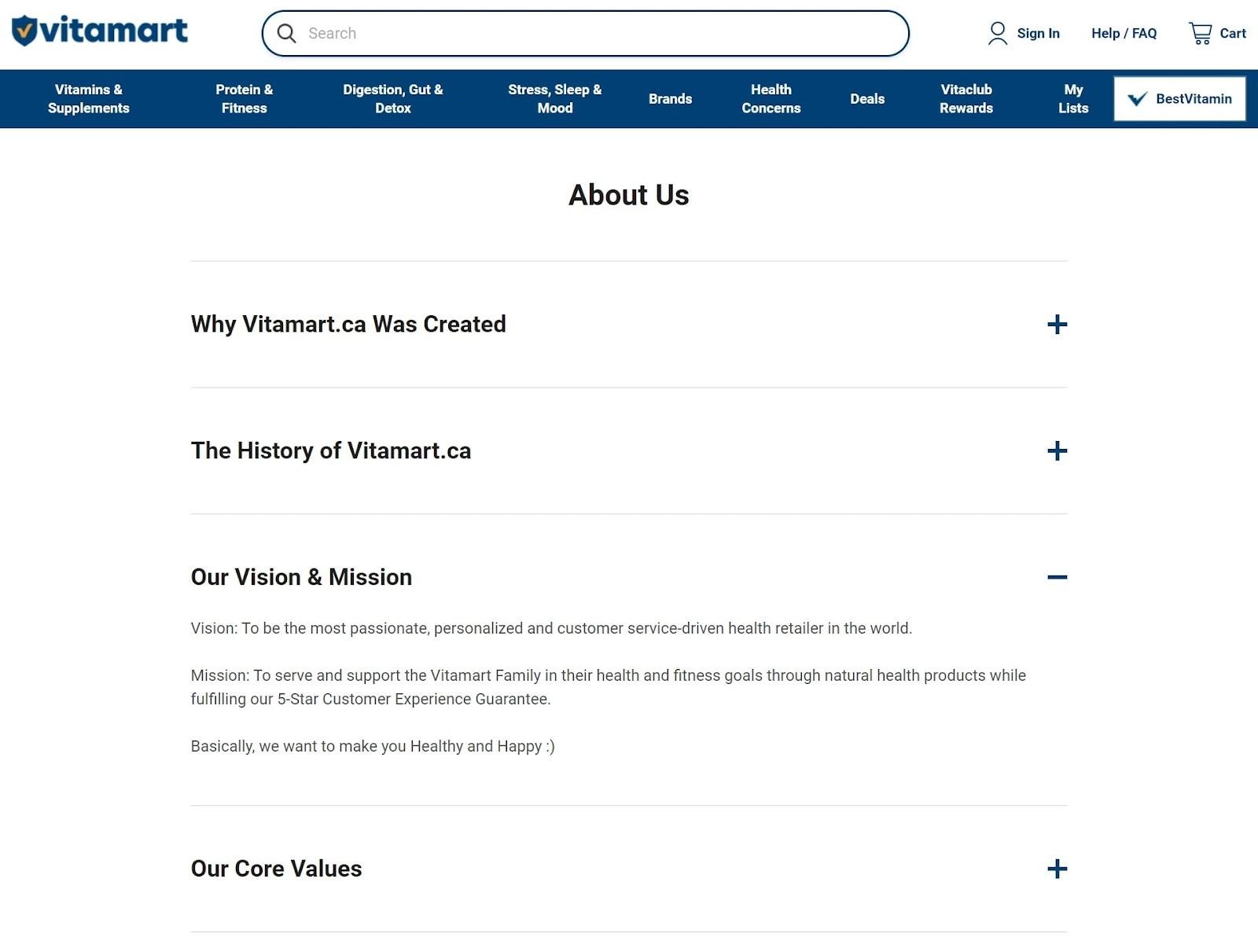
Vitamart’s solution was to build an online health store that combined convenience with exceptional customer service. By addressing the issues he encountered, Mark made sure Vitamart went above and beyond what customers expected. His focus on a personalized, customer-first approach is what really makes Vitamart stand out.
Vitamart’s founder incorporated storytelling of its brand by sharing the history, vision, and mission of the brand to cope with the challenges. This increased the consumer’s trust and acted as a perfect marketing strategy.
5 Key Elements of Effective Brand Storytelling
So, what makes a brand story really connect with people? These are 5 main things to look for:
- Emotional Connection: People connect better with your brand when you tell a story that evokes an emotional response. Research shows that consumers emotionally connected to a brand have a 306% higher lifetime value.
- Differentiation: A unique brand story is the best way to stand out in a crowded market. A compelling story sets you apart from other companies that sell similar products. 77% of consumers buy from brands that share their values.
- Consistency: Consistent storytelling across all platforms, including social media and review sites, reinforces your brand’s message and core values.
- Engagement: Sharing true stories about your business’s history, mission, and values will engage your readers and keep them interested. Research proves that engaged customers bring 23% more revenue to a company.
- Trust and Loyalty: Both increase when customers relate to the brand’s story. It helps you build a lasting relationship with your audience while boosting your marketing efforts. 43% of customers spend more money on brands they’re loyal to.
Examples of Successful Brand Storytelling
Brand stories inspire the audience to take action. Let’s see how real brands use brand storytelling to achieve this goal. When reviewing these examples, focus on how each brand uses storytelling to create emotional connections, engage their audience, and incorporate feedback to strengthen their message.
1. Apple’s Emotional Messaging
Apple is one of the most recognizable brands for innovation and technology. They understand that communicating with their audience in their niches can be challenging.
So, when creating their brand stories, they prioritize their audience’s specific experiences and emotions. They use their products and services to solve problems and make customers feel even better.
Apple delivers this using emotional messaging. This marketing strategy highlights the product’s benefits and features and matches them with the audience’s feelings, needs, and problems. One brand story that stands out is the introduction to their Wonderlust event.
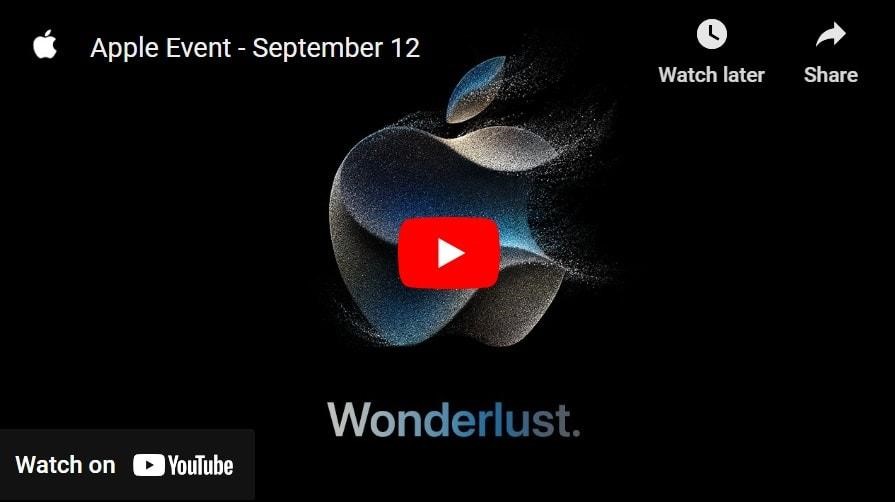
Apple nailed the emotional storytelling during the launch of new gadgets (Apple Watch Series 9, Apple Watch Ultra 2, and iPhone 15 Pro). They highlighted the product’s latest features by sharing real-life anecdotes and testimonials of people living healthy and happy just because of this innovative detection technology.
The updated sensors and technology helped users save lives; crash detection or unconscious sensors automatically called 911, irregular heart rate tracking notified to see a doctor, and SOS feature rescued in emergencies.
This helped them to connect with people on a real level and show how their products can make a real difference by adding value to their lives.
Key Takeaway
From product launches to marketing campaigns, Apple has proven itself a master of brand storytelling. Every message and story it shares shows the company’s commitment to innovation and design excellence.
When using Apple’s brand storytelling strategy, always set the customer’s individual experience as a focal point.
Why? Because it’s all about making people feel seen. When you share stories, videos, or even what your customers are saying, it’s like inviting people into your world. they feel connected. They imagine themselves using your stuff and feeling the same way as the people in your stories. That’s how you build a real connection.
2. Raintree Nursery’s Golden Circle Strategy
Raintree Nursery knows that combining brand storytelling with gardening creates a strong emotional bond with the audience. It turns a simple hobby into a meaningful experience that connects deeply with people’s lives. When emotions are involved, every bloom and harvest becomes a cherished memory.
The brand used the Golden Circle strategy to inspire its audience to celebrate fresh, home-grown produce. This strategy has 3 key elements: why, what, and how. Simon Sinek developed this Golden Circle to improve brand storytelling. He suggests starting with ‘why’ questions because people care more about why you do something than just knowing what you do.
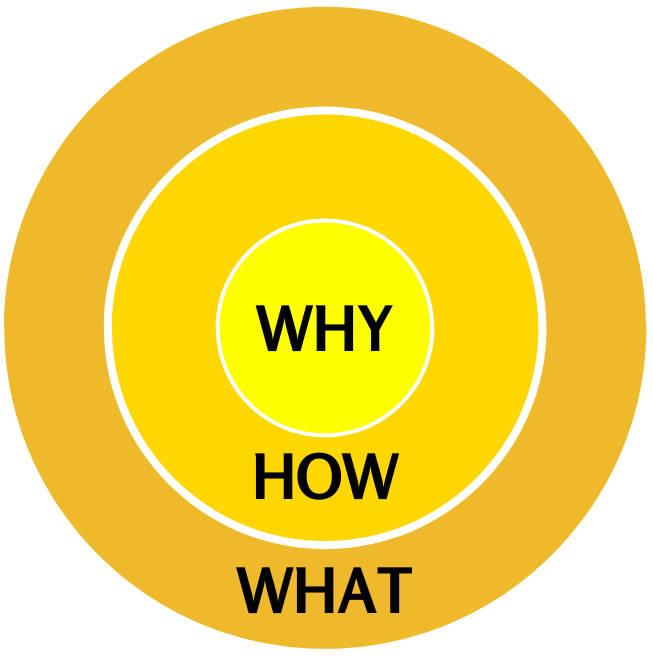
Here’s how Raintree Nursery used the Golden Circle strategy.
Why: Brand story’s Core Purpose
This is the layer where you explain the driving force behind everything your brand does. Raintree Nursery’s “why” focuses on its passion for producing quality home-grown foods.
They believe everyone should reduce their dependence on store-bought produce. They should instead have access to fresh and chemical-free produce straight from their garden.
How: Actions To Make Your “Why” A Reality
This is where you describe the necessary actions, processes, or steps to deliver your core purpose. Raintree Nursery started gathering tasty and easy-to-grow plants from around the world to help American gardeners grow their own produce.
To complement this, they offer:
- Community-Focused Workshops: Hands-on learning experiences promoting sustainable gardening and creating a supportive community.
- Personalized Support: Their chatbot provides tailored assistance for pre-orders, shipment tracking, and expert plant care advice.
- In-Depth Gardening Knowledge: Comprehensive blog articles covering unique plants, pest control, and organic cultivation, along with guidance on growing disease-resistant apple trees.
Through these initiatives, Raintree Nursery created a thriving community of gardening enthusiasts while fulfilling its commitment to exceptional plant quality and customer care.
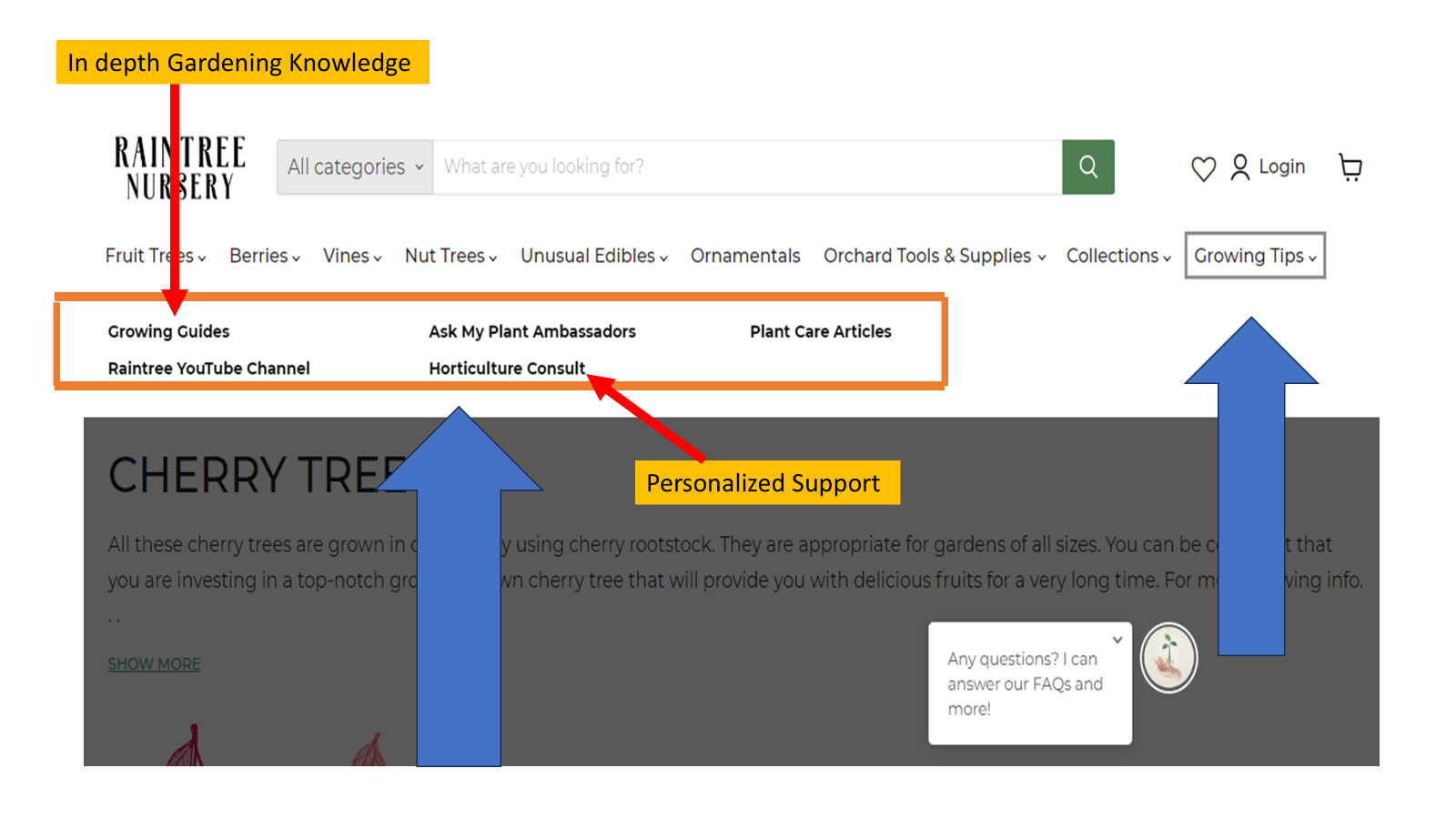
What: Present Your Products Or Services
In the Golden Circle framework, the “What” tier is a deeper level of the concrete value your business provides. It addresses the question: “How do your products or services solve customer problems?”
Raintree Nursery exemplifies this by offering more than just plants. They handpick a variety of fruit-bearing trees, climbing plants, rare edibles, and decorative flora, each chosen to thrive in specific conditions.
By offering this all-encompassing solution, Raintree helps customers overcome common gardening hurdles. Their “What” is about delivering a full gardening experience designed for customer success along with product sales.
Key Takeaway
Always listen to your customer’s feedback when using the Golden Circle strategy. Regularly collect and analyze feedback from various sources to understand their needs, pain points, and preferences. Incorporating these insights refines your “how” and “what” layers as well as strengthens business credibility, a key characteristic of trustworthy and successful enterprises.
3. Greenhouse Emporium’s Sustainable Storytelling
Greenhouse Emporium specializes in greenhouses and greenhouse supplies and is creating a movement towards eco-friendly living. Through storytelling, it highlights its eco-friendly materials and the positive effects on urban living, which helps them connect with people who care about the environment.
Here’s how they weave their brand story:
- Sustainable Materials: Their kits are made from recycled plastics and eco-friendly sealants, minimizing environmental impact. Knowing it’s good for the planet, you can feel good about your purchase.
- Urban Oasis: Greenhouse Emporium educates you on its benefits – reducing food miles, boosting biodiversity, and improving mental well-being. They offer resources and tips to help you create your urban haven.
- Empowering Success: Greenhouse Emporium showcases customer stories about the environmental and community benefits their kits bring. These stories inspire others to get involved and be part of the push for a greener future.
- Community Collaboration: They partner with local organizations like community gardens and urban farming initiatives. This collaboration helps spread their message and empower more people to join the movement.
Key Takeaway
Cue from Greenhouse Emporium’s storytelling? Show how your brand is making a difference by focusing on your commitment to a bigger cause – like sustainability or community impact. Share real-life stories and the tangible benefits your products or services provide.
When you show how you’re genuinely improving lives and making an impact, you’ll create a story that truly connects with your audience.
7 Proven Strategies For Successful Brand Storytelling
As you go through these strategies, focus on the parts that will help you create genuine connections with your audience and set your brand apart.
I. Avoid Stereotypical Characters
The purpose of brand storytelling is to reach and attract a diverse audience. So, make sure you create narratives that resonate with different backgrounds, cultures, and perspectives.
Here’s how to do it:
- Create story arcs that show the character’s personal growth and evolving journey.
- Use respectful and appropriate language based on the character’s background
- Seek audience feedback to find any inaccuracies, biases, or gaps.
- Develop each character with a unique set of personalities, strengths, dreams, and weaknesses/challenges.
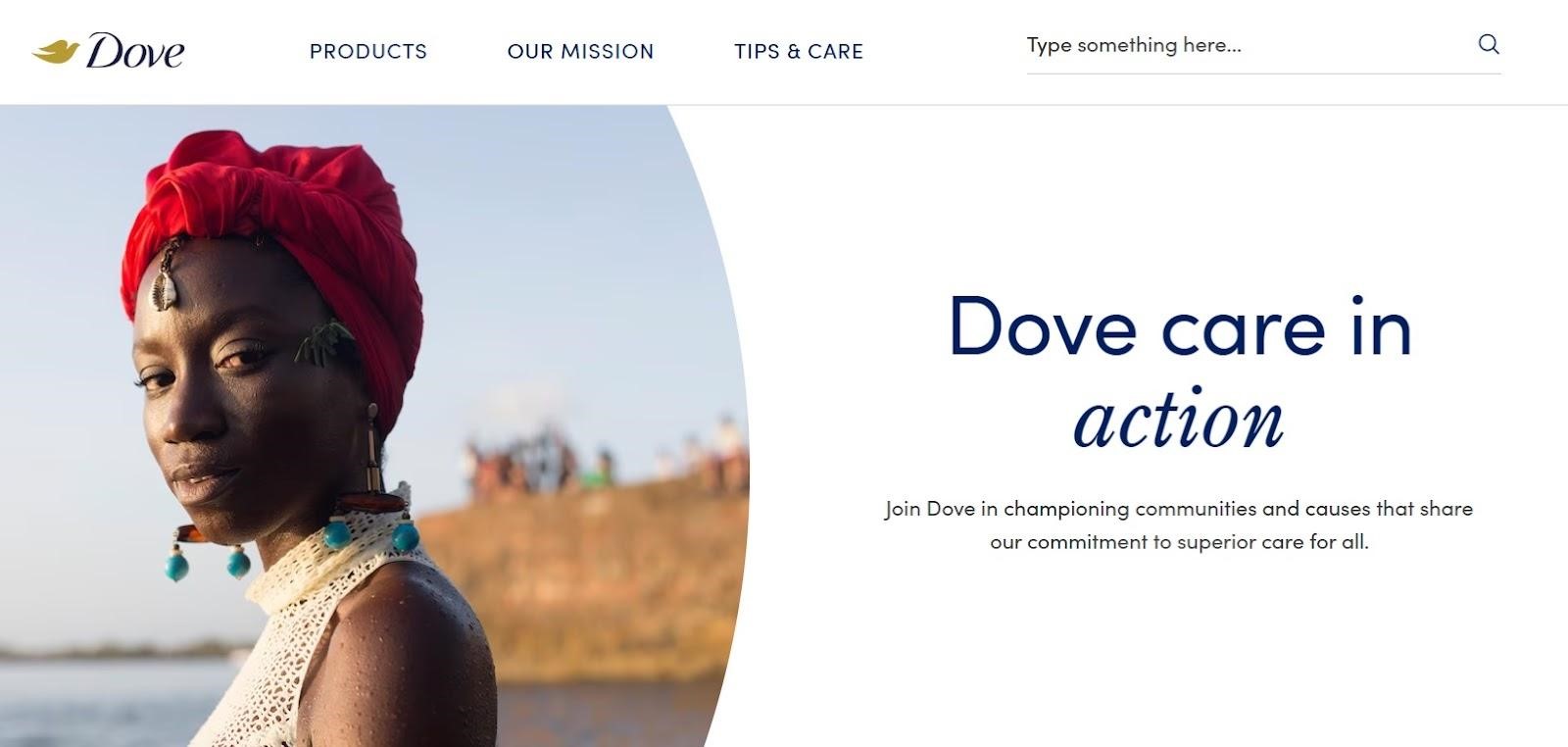
Dove is a prime example of showcasing diversity in their brand’s “Real Beauty” campaign. Instead of sticking to stereotypical images of beauty, Dove features real women from all walks of life—different backgrounds, body types, and ages. Their ads share personal stories that feel relatable and break away from the usual beauty standards you see in the media.
They make sure to use language that’s respectful and honors each person’s unique experience. Dove also involves their audience and gets their feedback to make everyone feel included. This approach creates a stronger, more authentic connection with their audience.
II. Align Your Brand Narrative to Your Brand’s Values
Align your brand story with its core values to create a strong one. This alignment ensures your narrative connects deeply with your target audience. It also accurately reflects your brand’s mission.
Here’s how to do it:
- Show real impact. Emphasize how your brand’s values produce observable results and behaviors. Share real-life examples that demonstrate the brand’s mission which benefited customers and the community.
- Incorporate the customer’s voice. Customers’ words and stories can show how your brand’s values resonate. To truly understand and represent your customers:
- Conduct surveys and interviews to gather firsthand accounts.
- Use social media listening tools to identify customer sentiment.
- Highlight successful customer experiences in your marketing.
- Design a space on your website for reviews and testimonials.
- Promote user-generated educational content through contests and campaigns.
- Emphasize long-term vision: Your brand’s values shape your future objectives and strategies. Tell your audience that your long-term plan revolves mostly around your dedication to these principles.
For example, TOMS Shoes embodies its brand values by showing real stories of how its “One for One” giving model has transformed lives. Basically, every time someone buys a pair of TOMS shoes, the company donates a pair to someone in need. This way, you can see exactly how your purchase makes a difference, making their brand values feel genuine and personal.
You can too highlight your vision, include customer feedback, and show real results to build a strong brand story that connects with your audience.
III. Publish Content the Right Way
Publishing content material successfully on social media goes beyond merely “posting.” It’s about conveying your viewpoint to the right audience in the right way.
Here’s how to do it:
- Choose the platforms where that are most active for your target audience is most active.
- Optimize every platform. Your material’s format and style should be customized for each platform’s needs.
- Plan strategically to post when your audience is most likely to participate.
- Strengthen bonds, actively engage, and respond to messages and comments.
- Track how your content performs using analytics tools, then change your approach.
Simply Beach is a fantastic example of getting social media content just right. They sell beachwear and have picked Instagram – spot on for their visual, beachy vibe. They have taken it a step further by categorizing their posts by brands, which makes it super easy for followers to find exactly what they’re looking for.
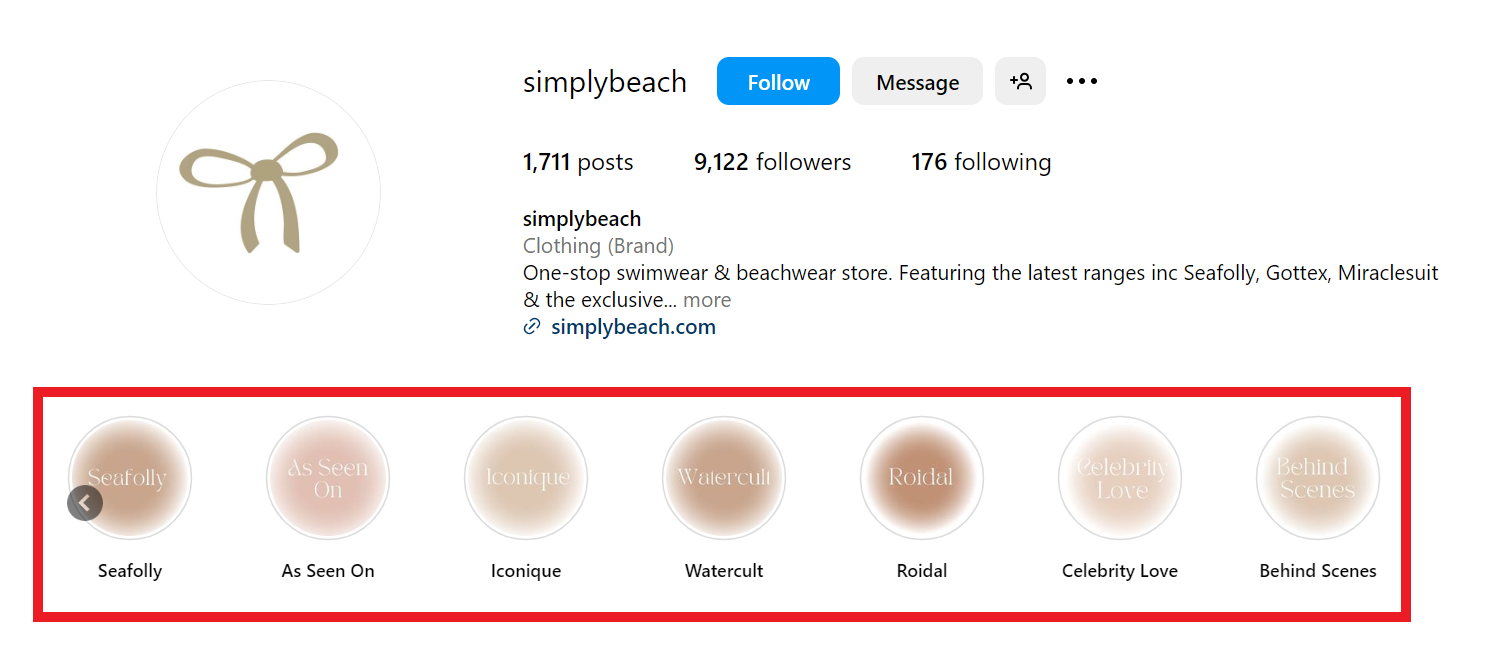
What really sets them apart is their separate section featuring celebrities wearing their beachwear – something that’s not common among other brands in their space. This shows their products in a stylish, aspirational light and weaves a compelling story around them.
It’s a clever move that helps build a deeper connection with their audience and makes their brand feel more personal and relatable.
IV. Incorporate Visual Storytelling
Visual storytelling is an important part of brand storytelling. You can create an engaging brand story that resonates with your target audience using images, videos, and graphics. This method helps show brand values and main messages intriguingly and memorably.
Here’s how to do it:
- Use pictures that show what your brand stands for and what it wants to do.
- Make sure your visuals are consistent with your brand narrative and marketing strategy.
- Choose visuals that evoke an emotional response in your target market.
- Highlight how your customers creatively use their custom photos
Vinyl Status is a prime example of how to master visual storytelling, especially when it comes to selling custom stickers and decals. They’re in a niche where customers don’t buy these items all the time, so making a memorable impression is the most important point.
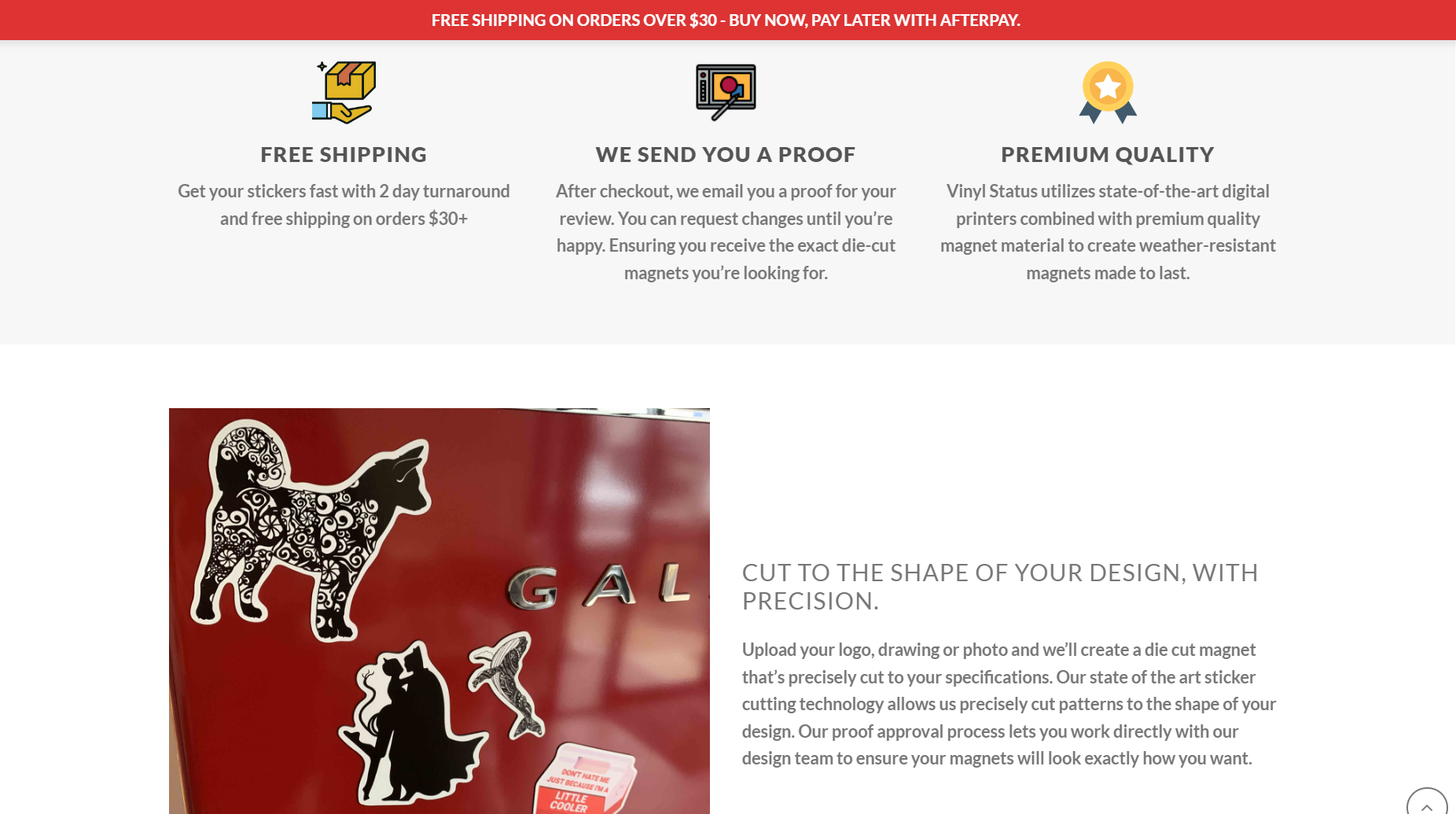
What Vinyl Status does exceptionally well is use visual storytelling to bridge the gap between infrequent purchases. They understand that stickers are discretionary items, so they make every interaction count.
One standout approach is their practice of sending proofs for approval before printing. This isn’t just about checking for errors; it’s a way to involve customers in the creative process and make them a part of the story. This way, they help customers see exactly how their custom designs will look in real life. This builds excitement and ensures that what they’re getting meets their expectations.
Vinyl Status also uses vivid imagery and customer-designed examples in its marketing. They show how their stickers and decals are used in various settings, turning ordinary objects into storytelling canvases. This helps potential buyers envision their designs in action, making the purchase feel more relevant and engaging.
V. Keep Your Story Skimmable
Make sure your brand story is straightforward to understand. Highlight how your products make a real difference, and weave this influence into the core of your brand’s story.
Here’s how to do it:
- Spotlight success: Feature customer transformations that show your product’s impact.
- Quantify improvements: Use data to illustrate the tangible benefits your products provide.
- Craft mini-sagas: Develop short, compelling stories about how your product solved specific problems.
- Reveal your roots: Share your product’s origin story, focusing on the problem it was created to solve.
- Visual storytelling: Use before-and-after imagery to demonstrate your product’s transformative effects.
Sugar Me Smooth is a standout example of keeping their brand story skimmable and relatable, and they’re doing something really special in their niche. They sell hair removal products which is a topic that can be pretty personal and sensitive.
Many businesses in this field shy away from showing real customer results because it can be awkward for both the business and the customers. But Sugar Me Smooth has embraced this challenge and turned it into a strength.
They make their brand story easy to follow by spotlighting customer success with compelling before-and-after images. This visual storytelling helps potential buyers quickly see the real impact of the products. This way, they create a narrative that’s both engaging and straightforward.

What’s impressive is that their approach has encouraged customers to share their experiences openly, something not many businesses in this niche can achieve. Sugar Me Smooth has managed to turn a potentially awkward topic into a powerful storytelling tool that really resonates with its audience.
VI. Leverage User-Generated Content
User-generated content (UGC) can be a powerful tool in brand storytelling. It adds authenticity and builds trust with your audience.
Here’s how to do it:
- Use customer stories. Ask clients to share experiences. Add these to your brand narrative.
- Feature real voices. Include authentic stories and testimonials. Make them key parts of your story.
- Focus on shared values. Build your narrative around the customer’s principles to create a relatable story.
- Guide content creation. Give clear prompts to help customers contribute effectively.
- Engage with user content. Respond to contributions. Make customers part of your ongoing story.
Infraredi is a perfect example of using user-generated content (UGC) to tell its brand story. They sell red light therapy products and you can see customer reviews everywhere on their site – on each product page, the homepage, and scattered throughout – so it’s nearly impossible to miss them. They’re making sure every review gets its moment to shine, which helps build trust and shows their products are really making an impact.
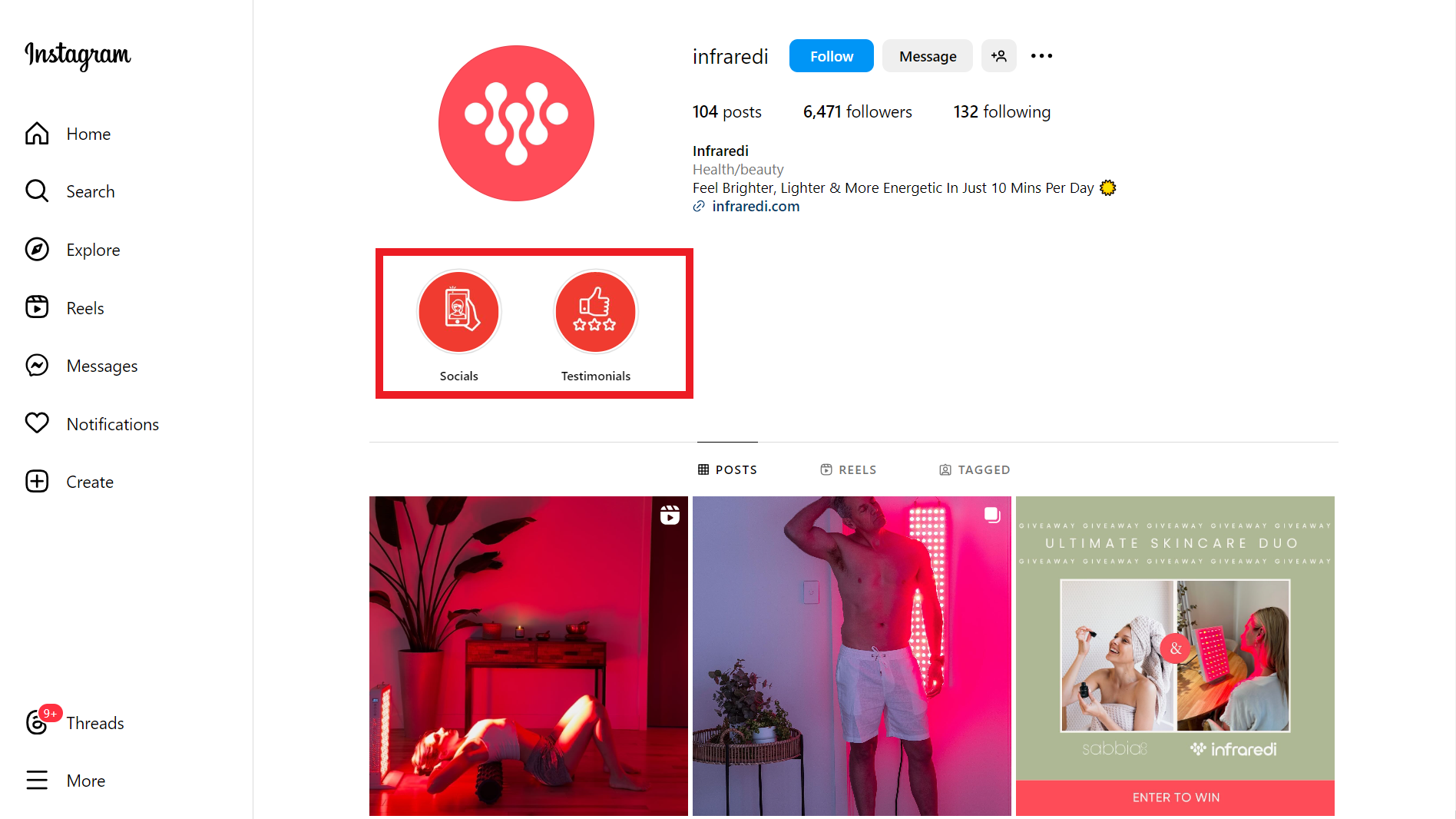
But what really sets Infraredi apart is their approach on Instagram. They’ve got a special tab just for user-generated content. One part features real customer reviews, while another shows reels and stories that users have made and shared on their social media accounts. No other company in their industry is doing this and it makes their storytelling really stand out.
Infraredi’s use of UGC goes beyond just filling up space; it actively involves its customers in its brand narrative which makes its storytelling more authentic and compelling.
VII. Create Interactive Brand Experiences
Engaging your audience through interactive experiences can make your brand story more memorable and impactful.
Here’s how to do it:
- Use interactive storytelling tools where users can make choices that affect the story outcome. This could be an interactive video or a choose-your-own-adventure style experience.
- Develop games or challenges related to your brand. For instance, a scavenger hunt or a branded trivia game can engage users while subtly promoting your brand’s message.
- Use augmented reality (AR) to let customers visualize products
- Offer personalized product recommendations based on user input
A great example of a business creating interactive brand experiences is Ovaeda. They’ve gone above and beyond with their interactive garden layout which lets you explore their products in a fun and engaging way.
Imagine a garden with typical settings – each area is like a heatmap that you can touch to learn more about what Ovaeda offers. When you tap on a section, it reveals what that space is all about. If you’re curious to go deeper, just click, and it’ll take you to a dedicated page where you can see how that product works and what elements are included.

It’s about creating an experience that pulls you in and makes the brand story memorable. Ovaeda has made it easy for customers to explore and interact with their brand, turning a simple browsing session into an engaging, hands-on experience.
What Ovaeda is doing with its interactive garden layout isn’t something you typically see from businesses in this line. Most just stick to the basics but Ovaeda has taken it a step further by creating an engaging, hands-on experience that really draws you in.
Conclusion
Brand storytelling is a strategic tool in modern marketing. It uses meaningful stories to connect with people emotionally and make your brand stand out. While researching these methods, think about how to use stories in your business. Look for low-cost ways of storytelling that can increase interest in your brand and improve it.
A memorable domain name can be a powerful storytelling tool in itself. ShortDot offers a range of short, impactful domain extensions like .bond and .icu that can help your brand tell its story concisely and memorably. Get in touch with us to discover how a short, impactful domain can be the foundation of your brand’s compelling story.
Author Bio:

Burkhard Berger
Burkhard Berger is the founder of Novum™. He helps innovative B2B companies implement modern SEO strategies to scale their organic traffic to 1,000,000+ visitors per month. Curious about what your true traffic potential is?
Gravatar: vip@novumhq.com
